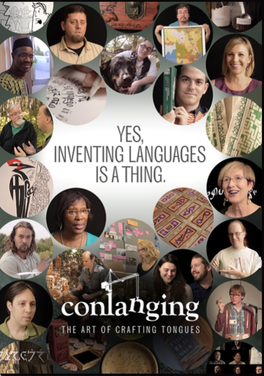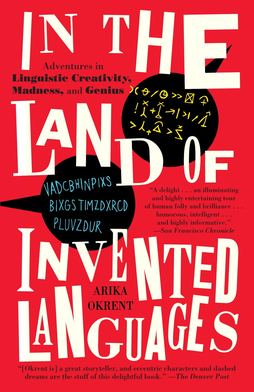
The Cirth is a semi‑artificial script, based on real‑life runic alphabets, one of several scripts invented by J. R. R. Tolkien for the constructed languages he devised and used in his works. Cirth is written with a capital letter when referring to the writing system; the letters themselves can be called cirth.
The Klingon language is the constructed language spoken by a fictional alien race called the Klingons in the Star Trek universe.

The Tengwar script is an artificial script, one of several scripts created by J. R. R. Tolkien, the author of The Lord of the Rings. Within the context of Tolkien's fictional world, the Tengwar were invented by the Elf Fëanor, and used first to write the Elvish languages Quenya and Telerin. Later a great number of Tolkien's constructed languages were written using the Tengwar, including Sindarin. Tolkien used Tengwar to write English: most of Tolkien's Tengwar samples are actually in English.

The Elvish languages of Middle-earth, constructed by J. R. R. Tolkien, include Quenya and Sindarin. These were the various languages spoken by the Elves of Middle-earth as they developed as a society throughout the Ages. In his pursuit for realism and in his love of language, Tolkien was especially fascinated with the development and evolution of language through time. Tolkien created two almost fully developed languages and a dozen more in various beginning stages as he studied and reproduced the way that language adapts and morphs. A philologist by profession, he spent much time on his constructed languages. In the collection of letters he had written, posthumously published by his son, Christopher Tolkien, he stated that he began stories set within this secondary world, the realm of Middle-earth, not with the characters or narrative as one would assume, but with a created set of languages. The stories and characters serve as conduits to make those languages come to life. Inventing language was always a crucial piece to Tolkien's mythology and world building. As Tolkien stated:
The invention of languages is the foundation. The 'stories' were made rather to provide a world for the languages than the reverse. To me a name comes first and the story follows.
The English philologist and author J. R. R. Tolkien created several constructed languages, mostly related to his fictional world of Middle-earth. Inventing languages, something that he called glossopoeia, was a lifelong occupation for Tolkien, starting in his teens.
The Black Speech is one of the fictional languages constructed by J. R. R. Tolkien for his legendarium, where it was spoken in the evil realm of Mordor. In the fiction, Tolkien describes the language as created by Sauron as a constructed language to be the sole language of all the servants of Mordor.
The Lhammas, Noldorin for "account of tongues", is a work of fictional sociolinguistics, written by J. R. R. Tolkien in 1937, and published in the 1987 The Lost Road and Other Writings, volume five of The History of Middle-earth series.
An artistic language, or artlang, is a constructed language designed for aesthetic and phonetic pleasure. Constructed languages can be artistic to the extent that artists use it as a source of creativity in art, poetry, calligraphy or as a metaphor to address themes such as cultural diversity and the vulnerability of the individual in a globalizing world. They can also be used to test linguistical theories, such as Linguistic relativity.
Elvish languages are constructed languages used by Elves in a fantasy setting. The philologist and fantasy author J. R. R. Tolkien created the first of these languages, including Quenya and Sindarin.

A constructed language is a language whose phonology, grammar, orthography, and vocabulary, instead of having developed naturally, are consciously devised for some purpose, which may include being devised for a work of fiction. A constructed language may also be referred to as an artificial, planned or invented language, or a fictional language. Planned languages are languages that have been purposefully designed; they are the result of deliberate, controlling intervention and are thus of a form of language planning.

The Klingons are a humanoid species of aliens in the science fiction franchise Star Trek.

Quenya is a constructed language, one of those devised by J. R. R. Tolkien for the Elves in his Middle-earth fiction.
Sindarin is one of the constructed languages devised by J. R. R. Tolkien for use in his fantasy stories set in Arda, primarily in Middle-earth. Sindarin is one of the many languages spoken by the Elves.
Dritok is a constructed language (conlang) created by Donald Boozer in 2007. Boozer was Secretary (2012–2015) and Librarian (2009–2013) of the Language Creation Society.
Bible translations into constructed languages include:

Conlanging: The Art of Crafting Tongues is a 2017 documentary film about conlanging – the hobby of constructing artificial languages and the people who make them. The film features conlangers David J. Peterson, Marc Okrand and David Salo, as well as Paul Frommer, linguistics professor and creator of Na'vi, and Christine Schreyer, anthropologist at the University of British Columbia, who hopes to be able to apply conlanging methods to endangered languages. The film also looks at the history of the hobby and modern-day conlangers. While the film was made available for online purchase in 24 August, a premiere was held on 22 July at the University of Calgary's Plaza Theatre. Production began in 2015, and received funding from the Social Sciences and Humanities Research Council of Canada, but the film's future was secured through an Indiegogo campaign that raised $25,000 during August 2016. The Language Creation Society provided $3,000 worth of funds towards the film and held an interview with Watkins.

In the Land of Invented Languages: Esperanto Rock Stars, Klingon Poets, Loglan Lovers, and the Mad Dreamers who Tried to Build a Perfect Language is a 2009 non-fiction book by linguist Arika Okrent about the history and culture of constructed languages, or conlangs, languages created by individuals. Okrent explores the motivations for creating a language, the challenges faced by such projects, and the outcomes of a number of high-profile conlangs. The book revolves around six conlangs: John Wilkins' unnamed 'philosophical language', Esperanto, Blissymbols, Loglan and its descendant Lojban, and the Klingon language designed for the Star Trek universe. Okrent describes her personal experiences learning and interacting with these languages and their speakers, and provides historical and linguistic analyses of their structures and features.
Tolkien's scripts are the writing systems invented by the philologist and fantasy author J. R. R. Tolkien. The best-known are Cirth, Sarati, and Tengwar.









